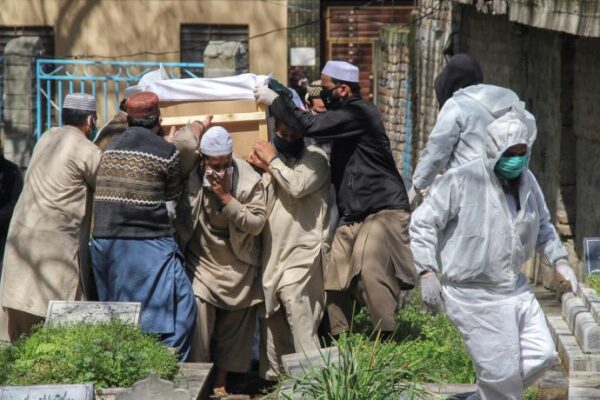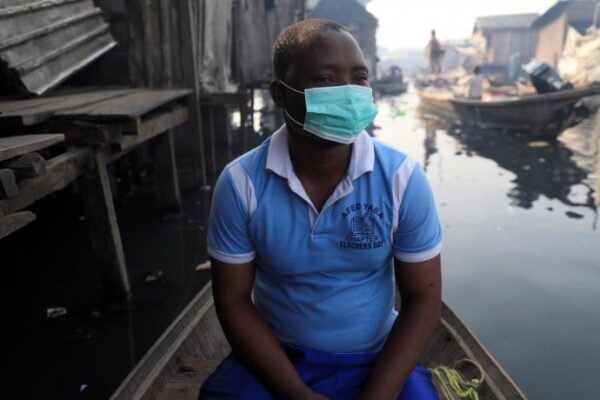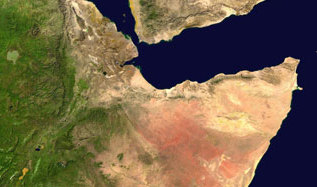PBS: Escaping Eritrea … [Read More...] about ካብ ውሽጢ ቤት ማእሰርታት ኤርትራ
When the Pandemic Hits the Most Vulnerable
Developing Countries Are Hurtling Toward Coronavirus Catastrophe

Imagine if virtually everything about the United States’ ongoing response to COVID-19, the disease caused by the novel coronavirus, goes wrong. That test kit shortages persist for months. That the country utterly fails to bolster the capacity of the hospitals and intensive care units and expand the supply of protective facemasks, gloves, and ventilators. That an already stretched health system proves incapable of tracing, isolation, and quarantine. That ordinary citizens fail to separate themselves from one another and most businesses stay open.
Now, imagine all of that, only several orders of magnitude worse. For any number of developing countries, such a scenario is not a matter of speculation. It’s a likely future, if not an imminent reality.
The novel coronavirus pandemic began mainly in developed countries theoretically better equipped to deal with its repercussions—whether China, South Korea, Singapore, or Italy. Although they, too, are struggling to cope, these nations enjoy relative affluence, strong institutions and political systems, and fairly effective medical systems by global standards. Were anything approximating what has hit those nations to afflict poorer or conflict-ridden ones, the effect could be crushing. That moment, unfortunately, may not be too far off: India, Pakistan, Brazil, Venezuela, Argentina, Nigeria, and South Africa each have hundreds, sometimes thousands, of cases. And as the experience of several current COVID-19 hot spots has shown, only a narrow gap can separate trickle from flood.
BRACING FOR IMPACT
As of now, it is unclear to what extent the disease has spread to less developed countries, as these do not currently test sufficiently, if at all, for the presence of the virus. Perhaps many of them will be spared a major outbreak, although there is yet no sound scientific rationale for why that might happen. The virus could be highly seasonal and less transmissible in more humid, warmer climates, but so far there is little evidence to support this. Seasonality is a characteristic of well-established viruses, to which people have had opportunity to develop at least partial immunity. This is because in a setting where the population is already somewhat immune, changes in temperature and humidity are far more likely to affect the ability of a virus to spread. But in the case of the new coronavirus, such partial immunity is still lacking entirely. Singapore, despite its consistently warmer and more humid climate, was one of the first countries affected. Any impact weather might have on the coronavirus likely would be modest at best, delaying catastrophe rather than preventing it.
Known COVID-19 risk factors, such as obesity, cardiovascular disease, or hypertension, are more prevalent in high-income countries. Older populations are also more likely to suffer the disease’s worst consequences, whereas many developing countries skew toward the younger. Together, these facts could mean that the virus will hit lower-income countries less harshly. Again, however, any possible benefit would be slight: obesity and cardiovascular disease are still prevalent in poorer countries, whose populations also have to contend with a number of other health issues and environmental conditions that exacerbate the virus’s lethality, from chronic malnutrition to HIV/AIDS, tuberculosis, smoking, and poor air quality. And even the young are at some risk: COVID-19 can be lethal in individuals in their twenties, especially where urgent medical care is lacking.
“COVID-19 will almost certainly strike developing countries.
The bottom line is that COVID-19 will almost certainly strike developing countries. The current low numbers are due either to a lack of detection or to the time lag between when the virus first spreads and when it begins to manifest. When it does strike, it will do so with a vengeance, as these countries bundle together all the most potent risk factors. Their basic health infrastructure is inadequate. They often lack clean running water. They also have high population densities and family cohabitation structures that will impede physical distancing. And when workers depend entirely on their paycheck to survive and the government cannot afford to cover the difference, the cost of shutting down businesses becomes unimaginable. As Ethiopian Prime Minister Abiy Ahmed pointed out in the Financial Times, even a short interruption in planting or harvesting could have devastating consequences on his country’s food supply. All of this will inevitably be compounded by the dramatic global economic slowdown that awaits and which will hit fragile states the hardest, further damaging their resilience.
In short, the countries least able to impose physical distancing and perform contact tracing also tend to have the most overstretched health-care systems and the most precarious economies. A major COVID-19 outbreak in any of them could lead to an almost unfathomable number of dead. Estimates in the United States suggest that roughly five to ten percent of COVID-19 patients require hospitalization in intensive care units (ICUs). In most poorer countries, acute shortages of ICU beds occur even under normal conditions. The United States has roughly 33 ICU beds per 100,000 people. That number drops to around two in India, Pakistan, and Bangladesh. In sub-Saharan Africa, the situation is even more dire: Zambia has 0.6 ICU beds per 100,000; The Gambia has 0.4; and Uganda has 0.1. If the pandemic hits these countries or any others like them, they will almost certainly face a sudden surge of cases that will overwhelm their health-care systems. As a result, the fatality rate from COVID-19—which in wealthier nations is currently estimated to be between 0.25 and three percent—could be much higher in poorer countries. Because overstretched hospitals will not be able to care for people with other potentially treatable medical conditions, the overall mortality rate will be higher still.
The bottom line is that COVID-19 will almost certainly strike developing countries. The current low numbers are due either to a lack of detection or to the time lag between when the virus first spreads and when it begins to manifest. When it does strike, it will do so with a vengeance, as these countries bundle together all the most potent risk factors. Their basic health infrastructure is inadequate. They often lack clean running water. They also have high population densities and family cohabitation structures that will impede physical distancing. And when workers depend entirely on their paycheck to survive and the government cannot afford to cover the difference, the cost of shutting down businesses becomes unimaginable. As Ethiopian Prime Minister Abiy Ahmed pointed out in the Financial Times, even a short interruption in planting or harvesting could have devastating consequences on his country’s food supply. All of this will inevitably be compounded by the dramatic global economic slowdown that awaits and which will hit fragile states the hardest, further damaging their resilience.
In short, the countries least able to impose physical distancing and perform contact tracing also tend to have the most overstretched health-care systems and the most precarious economies. A major COVID-19 outbreak in any of them could lead to an almost unfathomable number of dead. Estimates in the United States suggest that roughly five to ten percent of COVID-19 patients require hospitalization in intensive care units (ICUs). In most poorer countries, acute shortages of ICU beds occur even under normal conditions. The United States has roughly 33 ICU beds per 100,000 people. That number drops to around two in India, Pakistan, and Bangladesh. In sub-Saharan Africa, the situation is even more dire: Zambia has 0.6 ICU beds per 100,000; The Gambia has 0.4; and Uganda has 0.1. If the pandemic hits these countries or any others like them, they will almost certainly face a sudden surge of cases that will overwhelm their health-care systems. As a result, the fatality rate from COVID-19—which in wealthier nations is currently estimated to be between 0.25 and three percent—could be much higher in poorer countries. Because overstretched hospitals will not be able to care for people with other potentially treatable medical conditions, the overall mortality rate will be higher still.
The bottom line is that COVID-19 will almost certainly strike developing countries. The current low numbers are due either to a lack of detection or to the time lag between when the virus first spreads and when it begins to manifest. When it does strike, it will do so with a vengeance, as these countries bundle together all the most potent risk factors. Their basic health infrastructure is inadequate. They often lack clean running water. They also have high population densities and family cohabitation structures that will impede physical distancing. And when workers depend entirely on their paycheck to survive and the government cannot afford to cover the difference, the cost of shutting down businesses becomes unimaginable. As Ethiopian Prime Minister Abiy Ahmed pointed out in the Financial Times, even a short interruption in planting or harvesting could have devastating consequences on his country’s food supply. All of this will inevitably be compounded by the dramatic global economic slowdown that awaits and which will hit fragile states the hardest, further damaging their resilience.
In short, the countries least able to impose physical distancing and perform contact tracing also tend to have the most overstretched health-care systems and the most precarious economies. A major COVID-19 outbreak in any of them could lead to an almost unfathomable number of dead. Estimates in the United States suggest that roughly five to ten percent of COVID-19 patients require hospitalization in intensive care units (ICUs). In most poorer countries, acute shortages of ICU beds occur even under normal conditions. The United States has roughly 33 ICU beds per 100,000 people. That number drops to around two in India, Pakistan, and Bangladesh. In sub-Saharan Africa, the situation is even more dire: Zambia has 0.6 ICU beds per 100,000; The Gambia has 0.4; and Uganda has 0.1. If the pandemic hits these countries or any others like them, they will almost certainly face a sudden surge of cases that will overwhelm their health-care systems. As a result, the fatality rate from COVID-19—which in wealthier nations is currently estimated to be between 0.25 and three percent—could be much higher in poorer countries. Because overstretched hospitals will not be able to care for people with other potentially treatable medical conditions, the overall mortality rate will be higher still.
Do the math: if nothing changes, the prospect of millions of deaths is far from unrealistic.

NEXT STEPS
What should be done? Governments in developing countries should, of course, do their best to impose physical distancing, enhance their capabilities for testing and contact tracing, isolate their most vulnerable citizens, and shift their budgetary priorities to public health. But in many places, these interventions will be hard to implement, and they go only so far. Ultimately, much of the response will have to come from the outside—from wealthier states, international financial institutions, and the global health community.
For developing countries, much of the response will have to come from the outside.
The first step is to take the full measure of the impending crisis, rather than simply hoping for the best just because the worst has not yet materialized. Some immediate steps would help: International organizations or individual states should urgently provide funds so that developing countries can produce or buy medical supplies. Budgetary support and debt relief could free up other resources. The UN has already issued a $2 billion appeal to combat the pandemic. It’s a start, but one that barely scratches the surface of need.
Whatever funds are made available should be spent wisely. Ramping up supplies of personal protective equipment to shield health-care workers makes perfect sense. By contrast, trying to substantially enhance existing ICU capabilities—by providing respirators, for example—would probably be misguided. Given the magnitude of the challenge, the priority should be to ensure that poorer countries can identify infected individuals and the people who were in contact with them and ensure that those with relatively mild symptoms can be diagnosed in testing centers or, ideally, at home rather than seek hospital care. That strategy is the best way to alleviate pressure on already strained health systems and save lives. To implement it, biotechnology companies, nonprofits, and international health organizations must join forces to develop and distribute low-cost testing tools.
Further down the road, if researchers manage to repurpose or develop a drug that can reduce the disease’s severity and make it less lethal, wealthier states should go against type: instead of prioritizing their own citizenry, they ought to simultaneously supply lower- and middle-income nations. The same goes for any future vaccine, which under a best-case scenario will be available 12 to 18 months from now. Because physical distancing and quarantine—the only alternative measures that currently exist to control the virus—are more difficult to implement in most poorer countries, global access to any effective therapeutic or vaccine should be considered a priority, not dealt with as an afterthought. Once the threat posed by COVID-19 has eventually died down, developing countries will once again need massive assistance—this time to help rebuild their economies and make sure they are better prepared for the next pandemic.
SPILLOVER EFFECTS
Paying attention to the plight of poorer nations will no doubt be a difficult sell at a time when all countries, rich and poor alike, are facing the pandemic and the economic destruction that lies in its wake. Public opinions will resist spending resources abroad when so much is needed at home.
But if humanitarian considerations won’t suffice to make the case, more practical ones should. A pandemic that knows no borders will have ramifications that ignore them, too. However effective border closures may be, they will never fully contain the virus—there inevitably will be seepage, allowing the virus to return to areas where it had been eradicated. Vanquishing COVID-19 only in some places will remain a short-lived success if the disease is not vanquished everywhere.
Even outside the medical realm, spillover effects are likely. Many developing countries could suffer massive death tolls, economic meltdowns, and skyrocketing unemployment and poverty. The resulting social upheaval could take many forms, from violent intrastate conflict to massive refugee flows, a growth in organized crime, or terrorist groups taking advantage of the spreading chaos—each of which could eventually affect Europe and the United States.
A crisis of epic proportions could lie ahead or perhaps is already smoldering, unseen but no less potent. For wealthier nations, helping the developing world weather both the immediate impact of COVID-19 and its longer-term costs is not simply an act of humanitarian altruism. It is a self-serving and urgent necessity.
